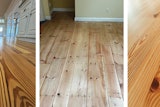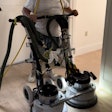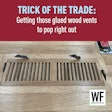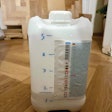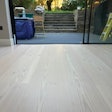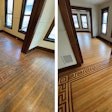Popping Putty
We did a job last winter where our installer puttied a select 21⁄4-inch red oak floor. Now that it is June, the relative humidity is higher and the boards are compressing, pushing the putty out between boards on nearly two-thirds of the install (about 1,500 square feet). The customer doesn’t like this, and it looks bad; what can we do?
Brett Miller, director of certification and education at the National Wood Flooring Association, answers:
The NWFA recommends filling floors with a wood floor filler or putty during the sanding process. However, it is never a good idea to fill floors during the winter months, when seasonal gaps are present. Seasonal gaps are defined as gaps between individual boards that close up during the humid seasons (summer months). When a wood filler has been applied to a seasonal gap during the dry seasons (winter months), the floor is at its smallest dimension. Once the RH increases and the wood begins to expand again, the newly applied filler will inhibit the wood from its natural movement.
The best scenario is that, like in this case, the filler is pushed out, which can catch your customers’ socks and can be very unsightly. The worst-case scenario is that the filler remains in the gaps, and the wood then has no option but to swell to the point of cupping, sometimes even crushing the edges of the boards.
The best repair for your situation is to carefully remove the loose filler by vacuuming and/or raking it out of the gaps, then heavily abrade the finish and recoat (this may require some stain/color repairs). If the floor has cupped, first stabilize the environment, allow the floor to reach your desired moisture content, and then address the issue, potentially resanding. Of course, the best scenario of all is to educate your customers about the necessity of maintaining a stable environment in their home so the wood doesn’t shrink and swell as much.
Creaky HDF Floor
My customer is complaining that the floor I installed is creaking. It’s engineered—1⁄32-inch veneer on the top and bottom and an HDF core—that I stapled through the tongue over a plywood subfloor. I was careful about flattening the subfloor. What might cause this?
Matt Skowron, owner at Lake City, Fla.-based The Floor Detective and an NWFACP-certified inspector, answers:
Ordinarily you wouldn’t have any problem nailing down an engineered floor on a wood subfloor, but you have to pay more attention to directions for engineered flooring with an HDF core. Typically these are floated or glued to the subfloor, but some HDF products actually require nailing by shooting the fastener through the bottom groove instead of the tongue.
HDF is comparatively brittle compared with wood, plywood and even particle board. It cracks easily, and the thinner it is, the easier it cracks. When tongues are cracked, the floor can move, and that’s going to cause those squeaks. Unfortunately, the only way to fix that floor is to remove it and replace it. You probably won’t be able to reuse any planks since most will crack or break when removed.
In the future, follow the installation directions. Given the option, I would always glue an HDF-core product. If you are above grade, glue it down with a premium adhesive; if you’re on or below grade, use a moisture barrier and premium adhesive, or a two-in-one product if you prefer. Either way, don’t forget to check the moisture in the slab before installing!
Extra Poly Coats?
I am getting a lot of requests lately from customers for three coats of poly. I usually do one sealer coat and two topcoats. Should I just do three coats to make them happy?
John Alford, president at Cincinnati-based A Step Above Wood Flooring & Installation Inc., answers:
I have also been receiving many requests like this lately. It leads me to believe that some contractors have nothing to sell but an extra coat of finish for a low price. Unfortunately, customers don’t know there is a difference between coats vs. mil thickness. Every finish manufacturer has a coverage rate on their packaging, and they have done significant testing to figure out what rate works best for the durability of their finish.
As a contractor, it is our obligation to our customers to give them the right coverage of finish on their floors. Because of their sanding and application techniques, some of these contractors offering three finish coats are realistically giving their customers only two coats at best.
Finish thickness will vary depending on the grit of abrasive and the machine used to finish a floor. It will also vary with what kind of applicator is used (e.g., lambswool, T-bar or roller), as well as the finisher who is coating the floor. If I want to save money on finish, I could make any of these applicators put a very thin coat of finish on the floor with just a little extra pressure on the applicator. The finishers at my company (me included) don’t even think about what the finish is costing us versus other finishes or other contractors—we just know that we are giving the end user the best wear layer we can and that we don’t have to recoat prematurely. Don’t try to chase your competition when they are bringing sales tactics to a new low or shortchanging the customer; just do what you know is right and be honest.









